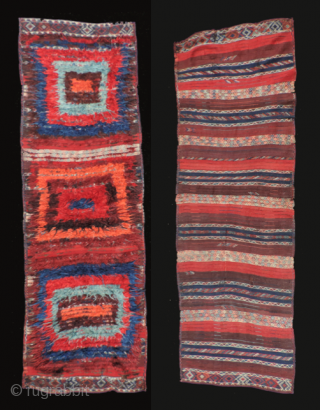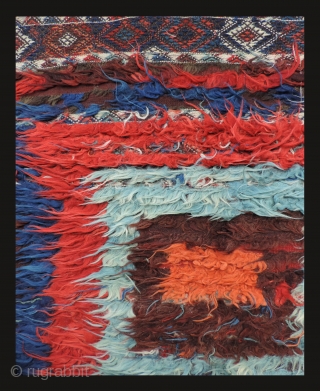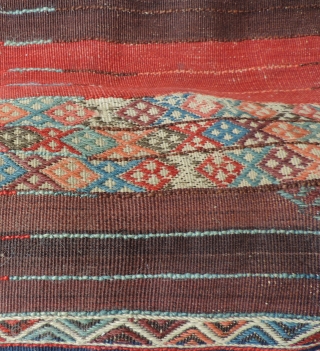Back
Primitive pile Kurdish rug, East Anatolia. 19th century. All dyes natural. This type of rug is discussed in Hali 100 in an article by John Wertime. a related example is published there as illustration 15 on page 94. Nineteenth century rugs of this type are rare especially when all dyes are natural as in this piece. These carpets have a very interesting and unusual structure and possibly purpose. The non-piled side shows a design in weft float brocading. The design on this (back?) side is what in other weavings with weft float brocading would be considered the front side of such a flat woven brocade. The pile side of this rug is long and shaggy with dyed, unspun (tufted) goat hair pile using the symmetrical knot. It has the distinction of having only about four knots to the square inch because the multiple wefts between each row of knots spans more than one inch in width - so only the horizontal rows of knots are counted in a square inch-type measurement. Interestingly, the so-called "front side" of the weft faced brocade patterning on this piece appears on what many would call the "back side" of this pile rug. This raises the question - is the pile on this piece intended more as insulation than as a design feature? Would this rug be used pile side down? If so why have a design on the pile side? Most likely the rug is simply a two sided rug meant to be used on either side depending on the situation. If one were to use this rug for a sleeping rug it is plenty long enough to lie on one half and pull the other half over as a blanket. The original sleeping bag? It would be warm - but a bit scratchy that's for sure . However it was used, the woven structure of this rug has all the hallmarks of a very early pile structure as Wertime points out in his article. This carpet is relatively clean and does not have an odor, but a careful cleaning would really bring out the best in the piece because the extra long pile is a bit disheveled looking and the fine fiber would take on a bit more sheen. The original sides and ends of this piece are intact. Size: 132 x 46 inches.
price:
SOLD
- Home
- Antique Rugs by Region
- Category
- Profiles
- Post Items Free
- Albums
- Benaki Museum of Islamic Art
- Budapest: Ottoman Carpets
- Gulbenkian Museum
- Islamic Carpets. Brooklyn
- Islamic Textiles. Brooklyn
- Konya Museum: Rugs
- MKG, Hamburg
- MMA: Caucasian Carpets
- MMA: Mamluk Carpets
- MMA: Mughal Indian Carpets
- MMA: Ottoman Carpets
- MMA: Safavid Persian Carpets
- MMA: Turkmen Rugs
- McCoy Jones Kilims
- Ottoman textiles. Met
- Philadelphia Museum
- Rugs and Carpets: Berlin
- Seljuqs at the Met
- TIEM, Istanbul: Carpets
- V&A: Classical Carpets
- Vakiflar Carpets: Istanbul
- Baluch Rugs: Indianapolis
- Gallery Exhibitions
- Jaf an Exhibition
- Alberto Levi Gallery
- Andean Textile
- Christie's London: 2016
- Francesca Galloway
- HALI at 40
- ICOC Washington, DC 2018
- Jajims of the Shahsavan
- London Islamic Week April, 2018
- Mongolian Felts
- Navajo Rugs: JB Moore
- Persian Piled Weavings
- SF Tribal & Textile Art Show 2020
- SF Tribal 2019
- Sotheby's: C. Alexander
- Turkish Prayer Rugs
- Turkmen Main Carpets ICOC 2007
















